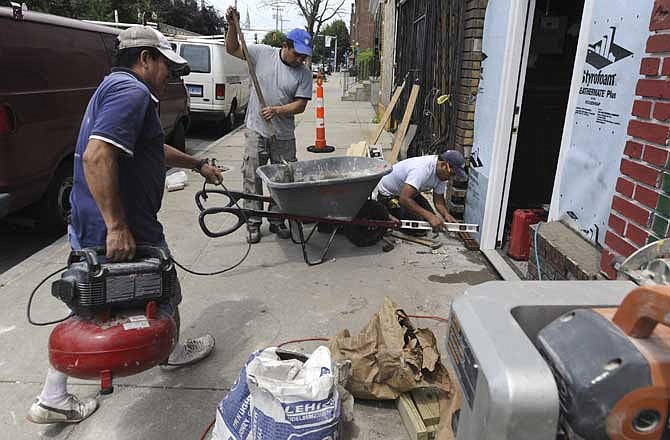BRIDGEPORT, Conn. (AP) - A year after a rare twister barreled down Bridgeport's Main Street, some buildings bustle with renovation work and the smell of fresh paint. But many others sit empty, their battered storefronts left as a reminder of the tornado that left trees toppled and nerves on edge in Connecticut's largest city.
As the anniversary approaches Friday, the initial shock has given way to tales of resilience and rebuilding. Some say recent twisters in Joplin, Mo., and Springfield, Mass., brought the early feelings rushing back, though - and reminded them that Bridgeport, which experienced no deaths, got off lucky.
"I think every one of us who worked last year's tornado, when we looked at Springfield and Joplin, we took a step back and said, "Whew, that could have been us,"' said Scott Appleby, Bridgeport's emergency management director. "We can replace property. We can't replace lives."
Replacing property has been challenging for some people, though, particularly since the Federal Emergency Management Agency twice rejected Bridgeport's request for financial help. FEMA set the damage tally around $3 million, while Bridgeport calculates it around $5 million, not including up to $17 million for the historic Barnum Museum and its contents.
Although Connecticut is no stranger to tornadoes, Bridgeport residents had little warning on June 24, 2010, that the winds whipping through neighborhoods and rattling their windows were about to evolve into a twister.
The tornado, later confirmed as a relatively low severity EF1 on a scale up to 5, left a swath of damage about 100 yards wide and two-tenths of a mile long on parts of Main Street. After it passed, stunned residents and business owners who'd scrambled for shelter emerged to find themselves surrounded by pieces of buildings, crushed cars, tree limbs and precarious piles of debris.
That debris is now gone, replaced in many places by buildings that have been gutted from the inside and are being rebuilt, particularly on hard-hit lower East Main Street.
Without FEMA money, city officials say, most property owners are relying on insurance proceeds. But not everyone affected by the tornado had insurance, particularly renters, and many have scattered.
"When all of the businesses were here, we fed off one another. We do still have our client base and they're coming back, but it's been a slow process," said Kyle Garnett, owner of New Creations Barber Shop & Beauty Salon and the three-story building in which it's housed. "What we want to see is for our neighborhood to come back."
Garnett, other barbers and customers ran to the basement as the tornado bore down on them that afternoon, blowing out their windows and spraying shards of glass and torrents of dirty water into the building. They had enough repairs in place to reopen the business about five months later, but are still working on renovations to the upper floors.
Not all businesses on lower East Main Street have been able to fight their way back. Some have closed, and others, including a neighboring bakery, have moved away.
Bridgeport, which is struggling to fill budget holes and faces the possibility of closing one of its schools, doesn't have the money to offer much financial help to property owners. And although the Small Business Administration offered low-interest disaster loans, some people who might have qualified said they steered clear because they were unsure of whether they could repay the debts.
One of the tornado's hardest-hit targets was the historic Barnum Museum building and its memorabilia from and about P.T. Barnum, the flamboyant showman and onetime Bridgeport mayor.
The blown-out windows have been replaced, though glass shards sometimes glint in the rugs even after dozens of passes with a vacuum. Debris coated many of the items, paint has started to flake on others, and the sudden blast of the storm's humidity into the carefully controlled climate allowed damaging moisture to permeate precious pieces.
Conservators specializing in woods, textiles and other items are being brought in to assess the damage and recommend how to reverse it, while structural repairs to the historical building also are being planned. The museum reopened once initial building repairs were made after the tornado, but it's been closed since winter as the major repairs are under way.
The museum is using its website to keep people interested and updated until the tentatively anticipated 2013 reopening. It's sharing its experiences with Springfield officials specializing in historical preservation.
"Seeing what happened in Springfield really brought the horrors of the day of the (Bridgeport) tornado all back to me," museum Executive Director Kathleen Maher said. "This experience for me would be completely in vain if I couldn't use what we've learned since then to reach out and help other organizations."
The tornadoes in Bridgeport, Springfield and Joplin were also jarring reminders that twisters don't differentiate between urban and rural targets. Amy Glasmeier, head of the urban studies and planning department at the Massachusetts Institute of Technology, said cities' recovery after tornadoes cannot be generalized because each case has so many individual factors.
"It can be heavily dependent on the economy that was there beforehand and the extent of social relationships beforehand, if an area was tight and there was some sort of social fabric," said Glasmeier, also a professor of regional planning. "That doesn't mean it has to be a suburban high-income community, but there has to be some system of reliance so that people trust one another and believe that something positive can come out of it."
In Bridgeport, Mayor Bill Finch believes something positive did come out of the tornado: proof of the city's resilience and improvements to emergency response planning. He and others say that a year after the tornado, their advice to people in Joplin, Springfield and elsewhere is simple: Don't give up.
"Keep good records and keep your wits about you," Finch said. "There's light at the end of the tunnel, and no, it's not a freight train."

